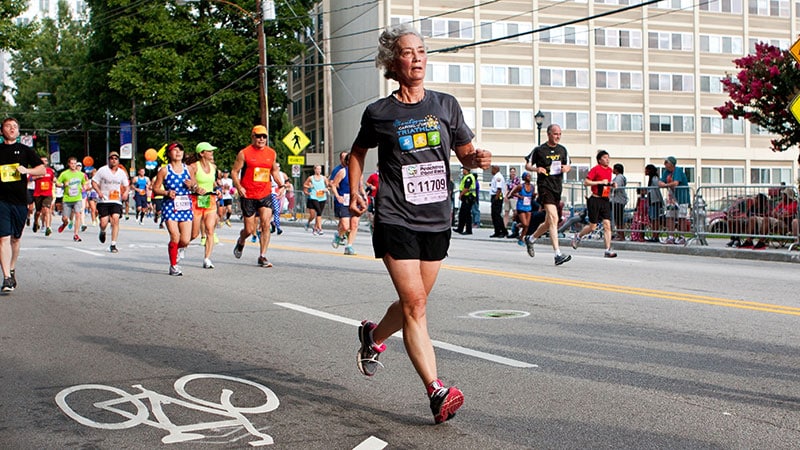The benefits of regular exercise likely outweigh the low risk of sports-related sudden cardiac arrest among community-dwelling US adults ages 65 and older, a new study suggests.
The analysis of sudden cardiac arrest events among close to 2 million older adults in Portland, Oregon and Ventura County, California, showed sport-related events were rare in this population, comprising only 1.9% of all sudden cardiac arrests among those age 65 years and older, with the vast majority (91%) occurring in men.
Furthermore, compared with those who experienced sudden cardiac arrest (SCA) events not related to sports, individuals with sports-related sudden cardiac arrest (SrSCA) had a significantly lower burden of cardiovascular risk factors such as hypertension, diabetes, obesity, or hyperlipidemia.
“As a cardiologist who is a (slow and steady) endurance runner, I am a firm believer in the benefits of exercise,” Sumeet S. Chugh, MD, of Cedars-Sinai Health System in Los Angeles, told theheart.org | Medscape Cardiology. “However, I was still surprised by the extremely low annual incidence of SrSCA in the two communities.”
“It is likely that the benefits of sports activity in the older adult far exceed the risk,” he said. “The small proportion that do suffer SrSCA are likely to have significant coronary artery disease that went undetected, or there was an unexpected clinical event.”
The study was published online January 18 in the Journal of the American College of Cardiology: Clinical Electrophysiology.
Fewer Risks or Comorbidities
The researchers investigated all out-of-hospital SCAs with resuscitation attempts in the Portland metro area (2002-2017) and in Ventura County (2015-2021) among 1.85 million participants in two large prospective trials. Those with SCA during or within 1 hour of cessation of sports activity were considered SrSCA.
Sports activity was defined as any physical activity conducted with the goal of recreation or maintenance of physical fitness or skill. “Gym activity” encompassed every activity an older adult might engage in in the gym, Chugh noted.
Among 4078 SCAs, 77 were SrSCAs (1.9%; 91% men). Based on conservative estimates of community residents age 65 and older who participate in sports activity, the SrSCA incidence was 28.9 per 100,000 sport participation years in Portland and 18.4 per 100,000 in Ventura.
The majority (77%) of SrSCAs occurred during sports activity (most commonly running, cycling, and gym activity); 17% occurred within 1 hour after cessation; and 6% could not be classified in either category.
Twenty individuals with SrSCA (26%) had warning symptoms — most commonly, chest pain (55%) — in the 24 hours preceding the event. Three (15%) had seizures and the remainder had nonspecific symptoms such as dizziness or nausea.
Among those with available medical records (47 SrSCA and 3162 non-SrSCA), individuals with SrSCA had a lower prevalence of clinical comorbidities compared with non-SrSCA cases, including heart failure (17% vs 38%), COPD/asthma (15.6% vs 35.8%), and hypertension (57.8% vs 80.1%). They also had had a significantly lower burden of cardiovascular risk factors such as hypertension, diabetes, hyperlipidemia, smoking, or obesity.
However, the prevalence of previously diagnosed coronary artery disease and myocardial infarction were the same between the groups (48.9% vs 48.1% and 27.7% vs 25.4%, respectively).
In addition, SrSCA was associated with public location as well as higher rates of bystander-witnessed and shockable rhythms. This resulted in survival outcomes that were fourfold higher than non-SrSCA.
“Sports activity in the older adult should be encouraged and these findings provide data that can be given to the patient so they can balance risk and benefit,” Chugh said.
“When providing an exercise/sports prescription it is important to follow clinical guidelines,” he added.
For older adults who are not accustomed to exercising, the researchers recommend a gradual increase in exercise over 6-8 weeks. An earlier review by Chugh and Joseph B. Weiss, MD, provides a schematic and details on increasing sports participation among older adults.
Hot Topic
Commenting on the study for theheart.org | Medscape Cardiology, Nikhil Warrier, MD, medical director of electrophysiology at MemorialCare Heart & Vascular Institute at Orange Coast Medical Center in Fountain Valley, California, said that after pro football player Damar Hamlin’s SCA on national TV earlier this month, “this has been a hot topic of discussion in a lot of my recent patient encounters. As a practice, we have a fair amount of patients that fit [the study] profile, with an overall healthier lifestyle and very low cardiovascular comorbidities. As a result, this study will have a significant impact in addressing this topic with them.”
“The limitations of the study are well described and are mostly related to data gathering since this was not a randomized trial,” noted Warrier, who was not associated with the study. “Additional research looking into which patients would benefit from preparticipation exercise screening would be ideal in an attempt to risk stratify these asymptomatic patients.”
Clinical assessment of any symptoms occurring during physical activity could also play an important role in assessing individual risk, he added. Meanwhile, like Chugh and colleagues, Warrier said “the overall benefits of sports activity likely outweigh the low risk of SrSCA in this patient population.”
No commercial funding or relevant financial relationships were reported.
J Am Coll Cardiol EP. Published online January 18, 2023. Abstract
Follow Marilynn Larkin on Twitter: @MarilynnL. For more from the heart.org | Medscape Cardiology, follow us onTwitter and Facebook
Source: Read Full Article
